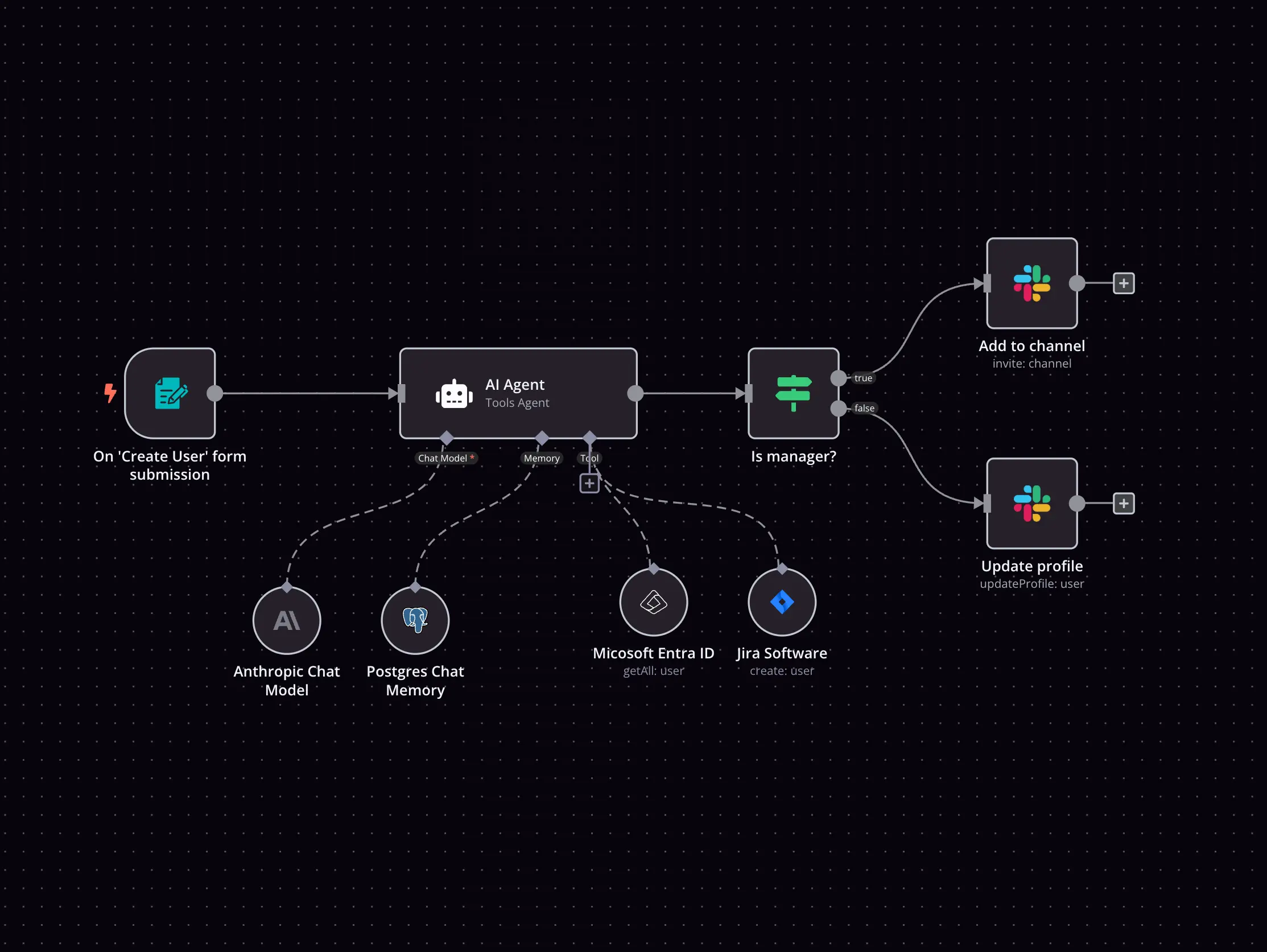Kaggle and Pipefy integration
Save yourself the work of writing custom integrations for Kaggle and Pipefy and use n8n instead. Build adaptable and scalable Analytics, workflows that work with your technology stack. All within a building experience you will love.


How to connect Kaggle and Pipefy
Create a new workflow and add the first step
In n8n, click the "Add workflow" button in the Workflows tab to create a new workflow. Add the starting point – a trigger on when your workflow should run: an app event, a schedule, a webhook call, another workflow, an AI chat, or a manual trigger. Sometimes, the HTTP Request node might already serve as your starting point.
Build your own Kaggle and Pipefy integration
Create custom Kaggle and Pipefy workflows by choosing triggers and actions. Nodes come with global operations and settings, as well as app-specific parameters that can be configured. You can also use the HTTP Request node to query data from any app or service with a REST API.
Supported API Endpoints for Kaggle
List competitions
List available competitions
List competition files
List competition files
Download competition files
Download competition files
Submit to a competition
Make a new competition submission
List competition submissions
Show your competition submissions
List datasets
List available datasets.
List files
List dataset files.
Download dataset files
Download dataset files.
Create dataset
Create a new dataset after initializing metadata.
Create dataset version
Create a new version of an existing dataset with version notes.
Download metadata
Download metadata for an existing dataset using its URL suffix.
Get dataset creation status
Get the status of the dataset creation process using its URL suffix.
List kernels
List available kernels based on specified filters.
Initialize kernel metadata
Initialize metadata for a new kernel setup.
Push code to kernel
Push new code to a kernel and execute it.
Pull code from kernel
Pull down the latest code from a kernel.
Get kernel output
Retrieve data output from the latest run of a kernel.
Get kernel run status
Display the status of the latest kernel run.
Get model
Retrieve a specific model using its URL suffix.
List models
Get a list of models with optional sorting and filtering.
Initialize model metadata
Create a metadata file for a new model.
Create model
Create a new model with specified metadata.
Delete model
Delete a model using its URL suffix.
Update model
Update a model by fetching its metadata file first.
Get model instance
Retrieve a model instance using its URL suffix.
Initialize model instance
Initialize a metadata file for creating a model instance.
Create model instance
Create a new model instance after initializing metadata file.
Delete model instance
Delete a model instance using its URL suffix.
Update model instance
Update a model instance after fetching its metadata file.
Create model version
Create a new version for a model instance.
Download model instance version
Download a model instance version using its specific URL suffix.
Delete model instance
Delete a model instance version using its specific URL suffix.
View current config values
View the current configuration values set in the system.
Set a configuration value
Set a new value for a specific configuration parameter.
Clear a configuration value
Clear an existing configuration value by name.
To set up Kaggle integration, add the HTTP Request node to your workflow canvas and authenticate it using a generic authentication method. The HTTP Request node makes custom API calls to Kaggle to query the data you need using the API endpoint URLs you provide.
See the example hereThese API endpoints were generated using n8n
n8n AI workflow transforms web scraping into an intelligent, AI-powered knowledge extraction system that uses vector embeddings to semantically analyze, chunk, store, and retrieve the most relevant API documentation from web pages. Remember to check the Kaggle official documentation to get a full list of all API endpoints and verify the scraped ones!
Supported API Endpoints for Pipefy
Create card
Creates a new card in the specified pipe.
Import cards
Imports multiple cards to the specified pipe.
Delete card
Deletes a card by its ID.
Move card to phase
Moves a card to a specified phase.
Update card
Updates an existing card
Lookup card by ID
Lookup a card by its ID
Fetch group of cards
Fetches a group of cards based on arguments
Fetch cards importer history
Lookup the cards importer history by the pipe ID
Fetch cards based on inputs
Fetch cards based on fields' inputs
Create comment
Creates a comment on a specific card.
Delete comment
Deletes a specific comment.
Create label
Creates a new label in the specified organization.
Delete label
Removes a specific label.
Update label
Modifies the attributes of a label.
Create organization
Creates a new organization.
Delete organization
Deletes a specific organization.
List organizations
Endpoint for retrieving a list of organizations.
Create phase
Creates a new phase within a specified pipe.
Delete phase
Removes a specific phase from a pipeline.
Create pipe
Creates a new pipe.
List pipes
Endpoint for retrieving a list of pipes.
Create table
Creates a new table in the specified organization.
Delete table
Deletes a specific table.
List database tables
Endpoint for retrieving a list of database tables.
Create table record
Creates a new record in the specified table.
Create webhook
Creates a new webhook for the specified organization.
Delete organization webhook
Deletes a specific webhook for an organization.
Update webhook
Updates an existing webhook.
Create webhook
Endpoint for creating webhooks to receive real-time updates.
Delete field condition
Removes a specific field condition.
Delete inbox email
Deletes an inbox email configuration.
Delete pipe
Deletes a specific pipe.
Remove user from organization
Removes a user from a specified organization.
List users
Endpoint for retrieving a list of users.
Set role
Assigns a specific role to a user.
Update field condition
Updates an existing field condition.
Create card relation
Establishes a relationship between two cards.
Update record
Updates details of a specific record.
Create authentication
Endpoint for creating authentication tokens.
Create service account
Endpoint for creating service accounts for authentication.
Create personal access token
Endpoint for creating personal access tokens for user authentication.
Example query
An example endpoint for making GraphQL requests.
Import records
Endpoint for importing records into the system.
Import cards
Endpoint for importing cards into the system.
Import records
Endpoint for importing records into the system.
Create organization webhook
Endpoint for creating webhooks specific to organizations.
Create pipe and table webhook
Endpoint for creating webhooks for pipes and tables.
List table records
Endpoint for retrieving a list of records for a specific table.
To set up Pipefy integration, add the HTTP Request node to your workflow canvas and authenticate it using a generic authentication method. The HTTP Request node makes custom API calls to Pipefy to query the data you need using the API endpoint URLs you provide.
See the example hereThese API endpoints were generated using n8n
n8n AI workflow transforms web scraping into an intelligent, AI-powered knowledge extraction system that uses vector embeddings to semantically analyze, chunk, store, and retrieve the most relevant API documentation from web pages. Remember to check the Pipefy official documentation to get a full list of all API endpoints and verify the scraped ones!
Kaggle and Pipefy integration details
FAQ
Can Kaggle connect with Pipefy?
Can I use Kaggle’s API with n8n?
Can I use Pipefy’s API with n8n?
Is n8n secure for integrating Kaggle and Pipefy?
How to get started with Kaggle and Pipefy integration in n8n.io?
Looking to integrate Kaggle and Pipefy in your company?
The world's most popular workflow automation platform for technical teams including
Why use n8n to integrate Kaggle with Pipefy
Build complex workflows, really fast


